
Dental Implants at Torgersen Dental, Camarillo & Simi Valley
Did you know that dental implants are frequently the best treatment option for replacing missing teeth? Rather than resting on the gum line like removable dentures, or using adjacent teeth as anchors like fixed bridges, dental implants are long-term replacements that can be surgically placed in the jawbone. Additionally, dental implants help to hold the bone in place and help prevent gum recession and the bone from desolving away.
Statistics show that 69% of adults ages 35 to 44 have lost at least one permanent tooth to an accident, gum disease, a failed root canal or tooth decay. Furthermore, by age 74, 26% of adults have lost all of their permanent teeth.
Twenty years ago, these patients would have had no alternative but to employ a fixed bridge or removable denture to restore their ability to eat, speak clearly and smile. Fixed bridges and removable dentures, however, are not the perfect solution and often bring with them a number of other problems. Removable dentures may slip or cause embarrassing clicking sounds while eating or speaking. Fixed bridges often affect adjacent healthy teeth, and removable dentures may lead to bone loss in the area where the tooth or teeth are missing. Recurrent decay, periodontal (gum) disease and other factors often doom fixed bridgework to early failure. For these reasons, fixed bridges and removable dentures usually need to be replaced every 5 to 15 years.
Today there is another option for patients who are missing permanent teeth. Composed of titanium metal that "fuses" with the jawbone through a process called "osseointegration," dental implants never slip or make embarrassing noises that advertise the fact that you have "false teeth," and never decay like teeth anchoring fixed bridges.
After more than 20 years of service, the vast majority of dental implants continue to still function at peak performance. More importantly, the recipients of those early dental implants are still satisfied they made the right choice. If properly cared for, dental implants can last a lifetime.

Before and after : Dental Implant
Anatomy of a Dental Implant
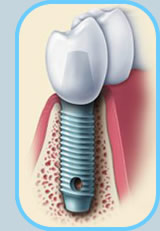 A dental implant designed to replace a single tooth is composed of three parts: the titanium implant that fuses with the jawbone; the abutment, which fits over the portion of the implant that protrudes from the gum line; and the crown, which is created by a prosthodontist or restorative dentist and fitted onto the abutment for a natural appearance.
A dental implant designed to replace a single tooth is composed of three parts: the titanium implant that fuses with the jawbone; the abutment, which fits over the portion of the implant that protrudes from the gum line; and the crown, which is created by a prosthodontist or restorative dentist and fitted onto the abutment for a natural appearance.
Many people who are missing a single tooth opt for a fixed bridge; but a bridge may require the cutting down of healthy, adjacent teeth that may or may not need to be restored in the future. Also, restoring a missing tooth with a bridge means splinting teeth together which will make flossing in between the bridge's teeth unavailable and it may cause gum problems. Then there is the additional cost of possibly having to replace the bridge once, twice or more over the course of a lifetime. Similarly, a removable partial denture may contribute to the loss of adjacent teeth. Studies show that within five to seven years there is a failure rate of up to 30% in teeth located next to a fixed bridge or removable partial denture.
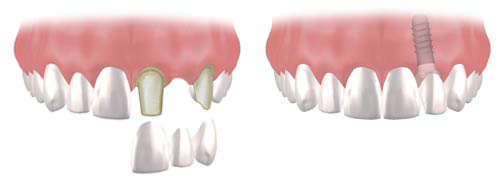 Fixed bridges may require the shaping or cutting down of adjacent healthy teeth.
Fixed bridges may require the shaping or cutting down of adjacent healthy teeth.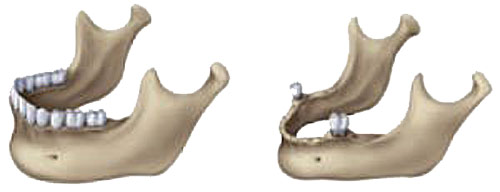 Bone is maintained by the presence of natural teeth or implants (a).
Bone is maintained by the presence of natural teeth or implants (a). Bone loss occurs with the loss of teeth (b).
Further, conventional dentures may contribute to the loss of bone in the area where teeth are missing. As illustration to the left indicates, the presence of natural teeth preserves the jawbone. When a tooth is missing, as in the illustration to the right, the bone may erode and weaken until it may be necessary for Dr. Trent or Gina Torgersen to graft bone to the area to strengthen it for placement of a dental implant. When a missing tooth is replaced by a dental implant, the fusion, or osseointegration, of the implant and bone provides stability, similar to as the natural tooth did.
If you are missing several teeth in the same area of your mouth, you may still enjoy the confidence and lifestyle benefits that come with dental implants. Drs. Torgersen will have placed two or more dental implants, depending on the number of teeth that are missing. Your replacement teeth will be attached to the implants to allow excellent function and prevent bone loss. The implants will serve as a stable support that tightly locks into your replacement teeth and dentures to prevent slipping and bone loss.
With an overall success rate of about 95% and almost 50 years of clinical research to back them up, dental implants are frequently the best treatment option for replacing missing teeth.
Dental Implants vs. Conventional Dentures
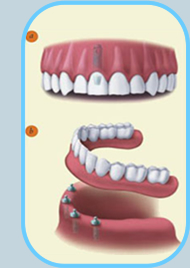 Implants can be used to replace one missing tooth so that the replacement looks and feels natural (top picture). Also, two or more implants can serve as a stable support for the replacement of many teeth (bottom picture).
Implants can be used to replace one missing tooth so that the replacement looks and feels natural (top picture). Also, two or more implants can serve as a stable support for the replacement of many teeth (bottom picture).
Many patients who have selected dental implants describe a quality of life that is much more comfortable and secure than the lifestyle endured by those with removable full or partial dentures. Dentures often make a person feel and look older than they are, causing embarrassment in social situations when they slip and click, and restricting the everyday pleasure of eating comfortably.
Dental Implants allow people to enjoy a healthy and varied diet without the restrictions many denture wearers have to face. With a sense of renewed self-confidence, many people rediscover the excitement of an active lifestyle shared with family and friends and the chance to speak clearly and comfortably with co-workers. For all these reasons, people with dental implants often say they feel better... they look better... they live better.
All-On-4 Dental Implant
Everyone deserves a confident smile. Now, there is no need to settle for anything less. With the All-On-4 solution, you can replace everything you've lost—from a great smile to the ability to eat anything you want!
The All-On-4 dental implant is a clinical solution that has been developed to maximize the use of available bone. It offers a new set of upper or lower replacement teeth for qualified patients - without bone grafts.
How does it work?
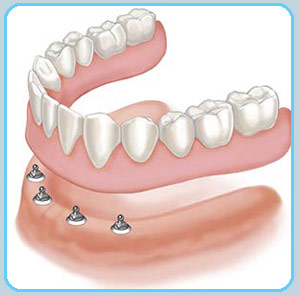 Using only four implants in edentulous jaws, this procedure takes advantage of the benefits of tilting the posterior implants to provide a secure and optimal prosthetic support for a prosthetic bridge, even with minimum bone volume.
Using only four implants in edentulous jaws, this procedure takes advantage of the benefits of tilting the posterior implants to provide a secure and optimal prosthetic support for a prosthetic bridge, even with minimum bone volume.
After all four implants are placed, a new or existing denture may be used as a temporary set of teeth to be attached. Patients leave the office with teeth in place, ready to smile, laugh, and eat over the 3 to 4 month period of bone-to-implant integration.
Typically, in 3 to 4 months, the implants will be fully secured by the bone. Your temporary teeth are removed and a flattering, final new set are permanently attached.
Can I have this dental implant procedure done?
Not all patients are candidates for the procedure. There are specific requirements and parameters that need to be present for dental implant. Once we determine if you are a candidate, we will let you know if the technique is appropriate for your long-term success of your implant.
Are You a Candidate for Dental Implants?
Whether you are a young, middle-aged or older adult; whether you need to replace one tooth, several teeth, or all your teeth, there is a dental implant solution for you. With the exception of growing children, dental implants are the solution of choice for people of all ages, even those with the following health concerns:
- Existing Medical Conditions: If you can have routine dental treatment, you can generally have an implant placed. While precautions are advisable for certain conditions, patients with such chronic diseases as high blood pressure and diabetes are usually successful candidates for dental implant treatment.
- Gum Disease or Problem Teeth: Almost all implants placed in patients who have lost their teeth to periodontal disease or decay have been successful.
- Currently Wearing Partials or Dentures: Implants can replace removable bridges or dentures, or they can be used to stabilize and secure the denture, making it much more comfortable.
- Smokers: Although smoking lowers the success rate of implants, it doesn't eliminate the possibility of getting them.
- Bone Loss: Bone loss is not uncommon for people who have lost teeth or had periodontal disease.
Call for your appointment today!


